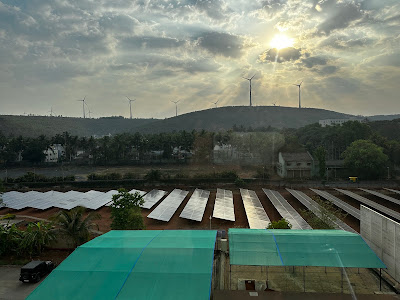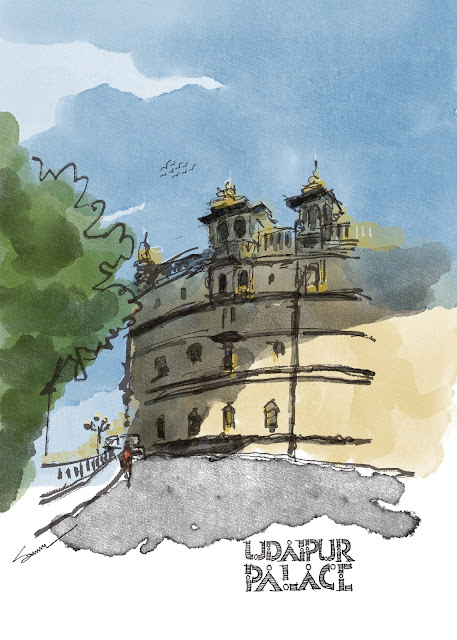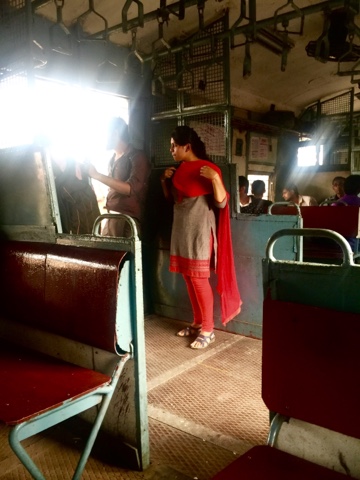EQ on GQ
The 'Electric Intelligence' by the Merc on the 'Golden Quadrilateral' of India.
In March 2025 I had gone for a 15 days long tour from Bangalore to Udaipur and back touching Belgaum, Pune, Mumbai, Surat, Baroda, Ahmedabad in-between for my professional, academic, social and spiritual purposes put together in an EV. This blog mainly focuses on the EV driving in India at the moment.
Since it is all about an EV, lets talk about the numbers before other matters.
THE ITERESTING FACTS :
- Total Distance travelled : 3954 kms
- Total driving time : 88 hours
- Overall average speed : 45 km/hr
- Number of charging : 15 times
- Lowest re-charge at : 17% of battery (only once)
- Highest re-charge at : 50% of battery (many of the time)
- Average re-charge at : 35% of battery
- Lowest charging time : 30 minutes
- Highest charging. time : 120 minutes
- Average charging time : 60 minutes
- Number of times in the queue for charging : 2 out of 15
- Longest queue time : 30 minutes
- Shortest queue time : 20 minutes
- Loss of time due to charging : 50 minutes out of 15 days
- Total cost for charging : Rs 13347
- Total Toll fees : Rs. 3500
- Average running cost only for charging : Rs. 3.38 / km
- Average running cost only for toll fees : Rs. 0.89 / km
- Average running cost including charging & toll fees : Rs. 4.27 / km
- Range of per KiloWatt charging cost : between Rs. 18 & Rs. 25
- Charging capacity used : 25 KW, 30 KW, 60 KW chargers
- Chargers used : Tata Power, ChargeZone, MobiLane, Hyundai ChargeZone, Nikol EV
- Driving Mode used : Comfort (out of Economy / Comfort / Sport / Personalised)
- Recuperation mode used : Most of the time Strong (out of Maximum / Strong / Normal)
- Top speed : 160 km / hour
- Speed range : mostly between 80 - 125 km / hour
- Power Naps : 4 times over 15 days each of around 15 minutes
- Number of passenger : only 1 for 13 days and 3 for 2 days out of total 15 days
- Luggage : 1 large suitcase, 1 duffle bag, 1 backpack
- Car Cleaning : only exterior body dusting for 4 times over 15 days and no water wash
- Road condition : ongoing road work for total of around 500 kms out of 3954 kms
- Drive timing : predominantly within day light except two days of drives upto midnight
- Traffic conditions : predominantly smooth including multiple cities
- Number of major cities driven by : 7
- Number of flats : none
- Number of times of tyre air filling : 2
- Number of times of Driver alert assistance message : 2 (more than 4-5 hours of non stop driving)
- Number of times of 'Range Anxiety' : none
- Number of times of feeling exhausted : none
- Number of times noticed the external wind noise : maybe around 2-3% of total drive time
- Number of times noticed the external tyre noise : maybe around 3-5% of total drive time
- Amount of cruise-control usage : maybe around 2% of total distance covered
- Usage of Hard-braking : none
- Usage of recuperation mode toggle : all the time as a substitute of actual braking
- Most used feature : paddle shifters
- Audio books listened : one and half books
- Music played : not more than 10 hours out of 88 hours
- Quiet driving time : none
- Pre-planning for charging stop overs : none and everything were decided on the go
- Average range of one full charge : around 510 kms
- Food and Sleep breaks overlap with charging : 14 out of 15 times
- Charging station did not work : 3 places but they were not critical
- Apps used to find out charging stations : Plugshare, ChargeZone, Tata Power, Fich
- Most useful Apps : Plugshare, ChargeZone, Tata Power
- Realtime updates of the charging data : very much accurate in all the apps
- Number of times had to call support line number of charging stations : 1
- Manned charging stations : only Hyundai charging stations operated by ChargeZone in day time
- Interruptions in-between charging time : 1 out of 15 times
- Wallet malfunction in the charging Apps : none
- Most appreciable charging station facilities : Hyundai charging stations operated by ChargeZone
- Split charging capacity due to dual guns : all except Hyundai as they have dedicated supply
- Average charging initiating time : around 2-3 minutes for topping up wallet and syncing up
- Average closure time of charging and ready to go : around 1 minute
- Total number of properly shaded charging stations : 7 out of 15 times
- Insecured feeling at the charging stations : 1 out of 15 due to the closure of the adjacent foodcourt
- Availability of toilet facilities around charging stations : everywhere
- Availability of food and beverages around charging stations : everywhere
- Number of pit-stops : 11 different places over the 15 days
- Any significant traffic jam or road closure experienced : none
- Accuracy of navigation systems : 96% combining sat-nav and google map
- Important navigation systems : compare inbuilt sat-nav with google map through intuition
- Key to an enjoyable multi-day tour in an EV : marrying the capacity of the machine with the driving pattern
- Most critical piece for the peace of mind in an EV long drive : having no hard target
- Number of times were delayed due to charging etc. : once delayed by 3 hours due to split charger delayed time than estimated coupled with navigation judgement
- Important thing to remember : reasonably good mobile network is a prerequisite for finding charging stations, topping up wallet, keeping the on-board network alive, syncing the car with mobile app for various functions
- Precautionary measures : keeping a long adaptive charging cord handy with a 3 pin plug coupler
- Cautionary considerations : look at the plugshare, fich, tatapower, chargezone applications' maps before venturing into any unknown territory
- Preparatory measures : download all possible EV charging mobile Apps in the device before starting the journey and anyone might help anytime anywhere when it is most needed
- A special mention : Gogte plaza at Belgaum has TataPower charging stations which are powered by adjacent windmills and solar power.
This was my first reasonably long tour in an EV and hope the listed points above provides sufficient input for everyone who are looking forward to this kind of tour in an EV.
This tour was not intended to anything else but to see in general how an EV can fare on Indian roads for a beyond the regular circuit situation and what are the promising factors already in place and what we need to expect in near future. The list above gives an overview of what are already available. And my observations for the future would be something like this below.
- The number of EVs are increasing rapidly and we would need many many many more charging stations very very soon otherwise there will be long queues at the limited charging stations which could be a spoil-sport.
- There are clearly few zones in India which are having reasonably workable charging infra but there are majority of territories which need immediate attention on all fronts to enable EV-friendliness.
- Due to lack of proper shades at the charging stations might pose issues in the rainy seasons which is significantly predominant and long in many parts of the country.
- Security of the charging stations in the night time is a big question at the moment and needs lot of enforcements rather fast at all the open zones.
- A more vibrant integration of the charging stations' accurate locations in the google map and the pop-up intimation feature of that in the mobile devices would facilitate even more peaceful drive.
- A proper intimation of the charger's capacity as a graphic at the location would be very useful to identify and plan everything.
- A more holistic one-app plotting of all the charging stations irrespective of service providers would be much more effective.
- Etiquette of using charging stations have to improve (including myself, as I am learning)
For this particular tour my plan overview is :
MARCH 2025
- 7 - bangalore pune
- 8 - pune mumbai
- 9 - mumbai ahmedabad
- 10 - Ahmedabad udaipur
- 11 - udaipur
- 12 - udaipur ahmedabad
- 13 - ahmedabad surat
- 14 - surat mulshi GMCKS ashram
- 15 - mulshi GMCKS ashram
- 16 - mulshi GMCKS ashram
- 17 - mulshi GMCKS ashram
- 18 - mulshi GMCKS ashram pune
- 19 - pune mulshi GMCKS ashram pune
- 20 - Pune Belgaum
- 21 - Belgaum Bangalore
The availability mapping of charging stations in Plugshare, ChargeZone & Tatapower apps are as bellow.
I'm not going to elaborate the experience part of this tour as it is mainly focused on various raw facts which I feel would be more appropriate for many who are at the fence of making a choice in a beautiful era of intelligent technology.
In essence, any EV which has a real world range of 300+ kms, is poised to become an all distance runner besides a very peaceful city commuter.
As the Golden Quadrilateral enthrals everyone, an EV on that would make the journey proportionately even more wonderful.
Wish you an electrified motoring ahead !
The best name of a charging station operator I found was 'Bijlify' on this route and for sure next time I will say hello to her.
And the customary of the farthest point of this tour !











































































